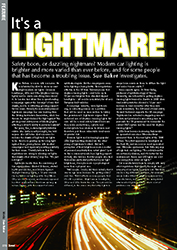 Right To Ride has been supporting Lightmare.org whose aim is to fight the growing road safety problem of blinding lights which affect drivers’ ability to perceive hazards.
Right To Ride has been supporting Lightmare.org whose aim is to fight the growing road safety problem of blinding lights which affect drivers’ ability to perceive hazards.
These lights put the most vulnerable and less conspicuous road users, for example pedestrians, cyclists and motorcyclists at risk.
Since Lightmare launched the campaign fully on 31st January, with an online petition to sign, they have had an encouraging response and a lot of press coverage particularly on the web.
Roy Milne from Lightmare and Drivers Against Daylight Running Lights, says, “We are getting such supportive feedback – many people affected by blinding lights thought it was just them, until they found so many others felt the same.”
Lightmare is a collaboration of worldwide voluntary groups of experienced motorists including scientists, engineers, mathematicians, lawyers and ophthalmologists, supported by leading pedestrian, cycling and motorcycling organisations.
Lightmare is committed to improving road safety by reducing glare and other distractions in the driving environment.
 The simple aim of Lightmare is to persuade the UK Government to introduce measures to limit the eye damaging intensity of lights that a driver encounters e.g.
The simple aim of Lightmare is to persuade the UK Government to introduce measures to limit the eye damaging intensity of lights that a driver encounters e.g.
- Daytime Running Lights – overbright
- Xenon headlights – blinding
- Misuse of brake lights – keeping foot on the brake when stopped
- Misuse of front and rear fog lights
- Illuminated distracting advertising
To keep the impetus on the campaign going, Diesel Car magazines journalist Sue Baker has written an article on Lightmare, which explains the people behind Lightmare and the issues of concerns regarding blinding lights.
Extracts from Diesel Car Magazine
New regulations effective in the UK from February mean that daytime running lights – said to be up to 50 per cent brighter than standard dipped headlights – will now be mandatory for all new European-built vehicles.
Bi-xenon lights and increasingly popular LEDs (light-emitting diodes) are the other prong of Lightmare’s attack. But isn’t perception of their brightness more a matter of personal sensitivity than actual glare? I put to Ken a comment made by a lighting expert at Audi, who told me that for people who find themselves particularly affected by car light brightness, it may be more a psychological issue than a physical one.
Bright xenon headlights, DRLs and LEDs fixate the eye. They should be diffused, in the same way that strip lights in shops have covers on them to diffuse the light and make it more subtle.
Some experts agree. Dr Peter Heilig, professor of ophthalmology at Vienna University, was influential in getting daytime running lights banned in Austria in 2006 when road safety statistics showed a 12 per cent increase in road casualties after they were made mandatory. The DIA head of road safety Howard Redwood supports the UK campaign: “Lightmare has collected a staggering amount of data and produced a very strong case to persuade the UK government to reconsider the current MoT system and the need for daytime running lights.”
LEDs have become increasing fashionable on up-market cars since Mercedes-Benz pioneered them in the rear lights of the 1998 S-Class. They first appeared in headlights on the Audi R8, and are now on most up-market cars. Mercedes spokesman Rob Halloway says of high-tech car lighting: “The safety benefits are extremely obvious, and it’s better for the environment. Xenon and LED lights use a lot less energy than older car lights.”
Car manufacturers have to comply with very strict regulations that specify the angle and intensity of car lights, he points out. “But there can be a big difference between, for example, xenon bulbs fitted as original equipment by manufacturers, and some of the unregulated after-market lighting. That’s where a lot of problems can arise.” DC
Don’t forget the online petition!



Speak Your Mind